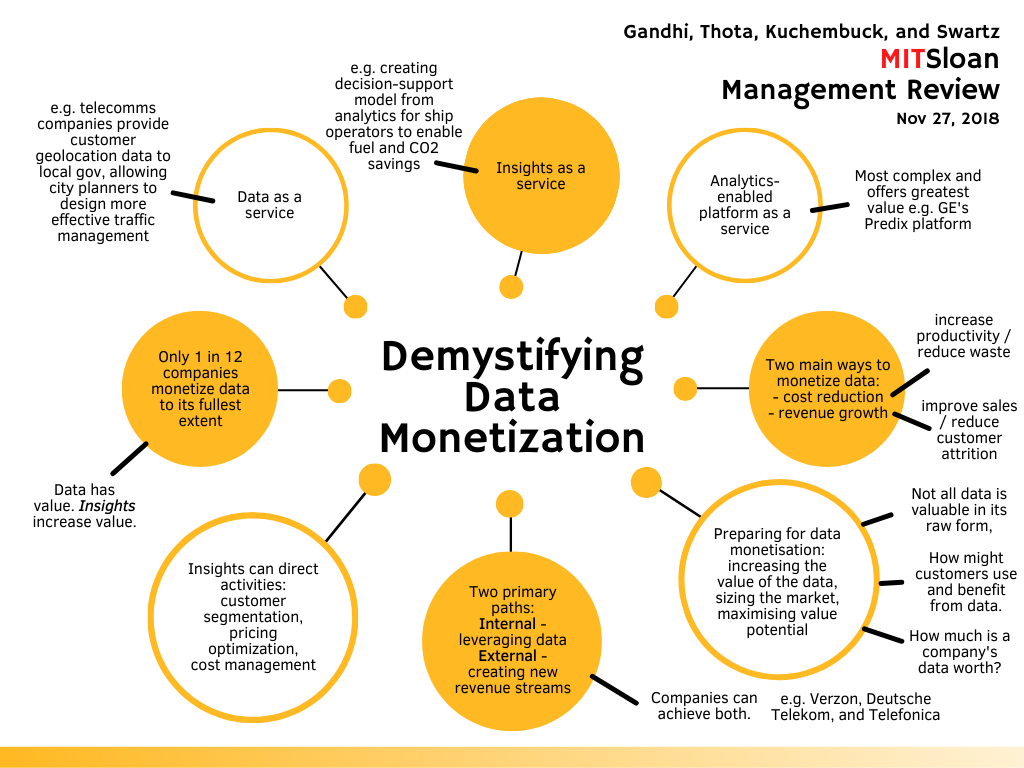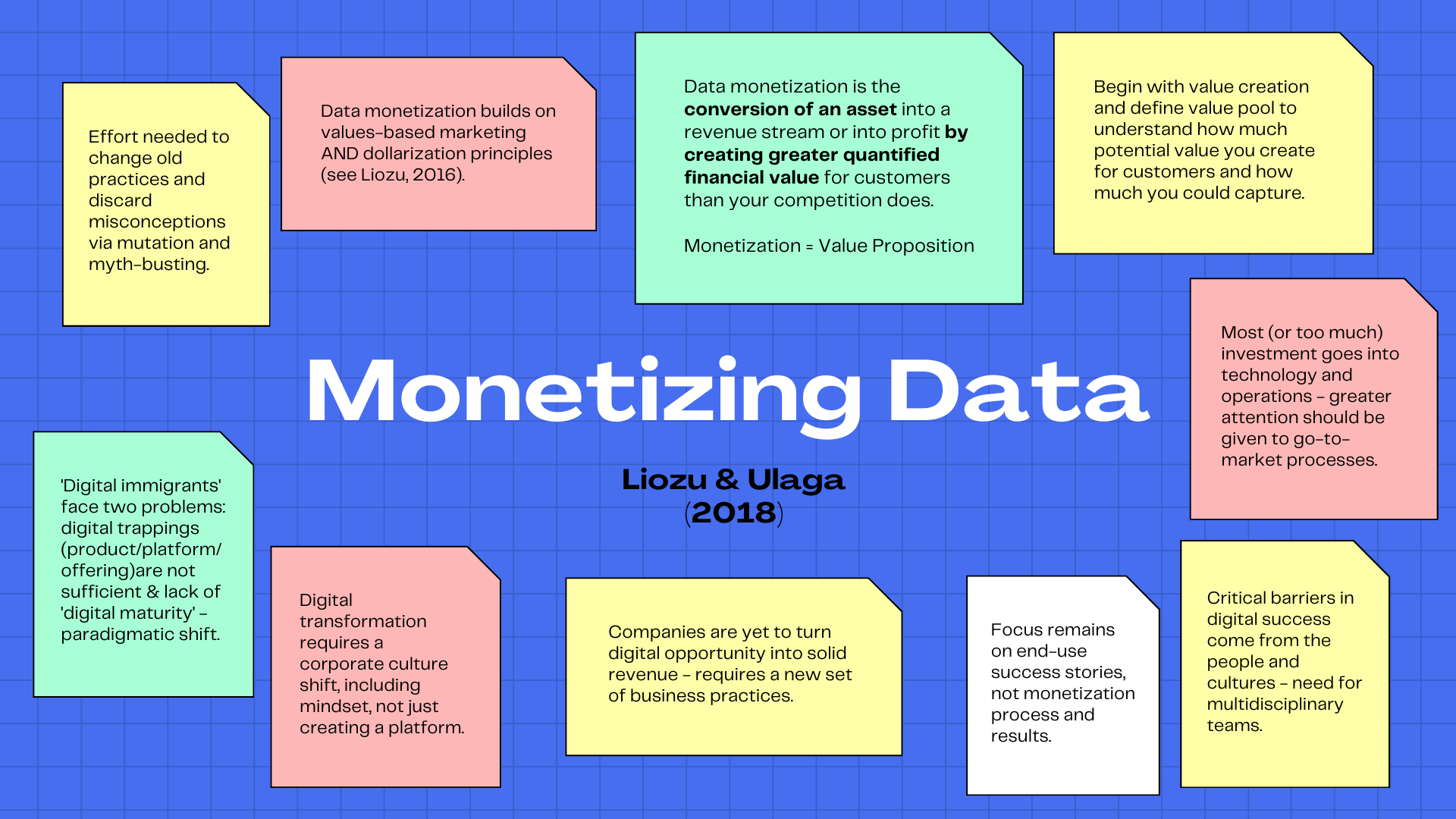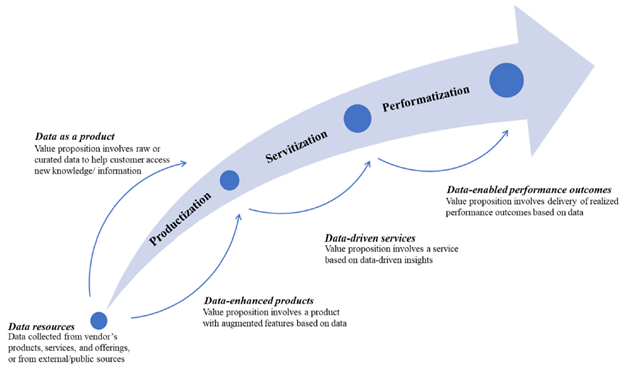Selling and monetizing data in B2B markets
This blog post is based on the findings of our research article, openly accessible and freely available here: https://doi.org/10.1016/j.technovation.2023.102935
What is data monetization?
Data monetization refers to the process of capturing monetary value from data by generating revenue through selling data, data-based products, and data-based services. It involves converting the intangible value of data into tangible financial returns.

Summary of ‘Demystifying Data Monetization’ (Gandhi et al., 2018). Created by author.
I was actually very new to this topic when I started this project, so as a fun way to get into the literature I generated a few visuals to help concretize the key learnings and takeaway. I share them here (above and below) to help give a snapshot of some of the foundational reading. At this time, I was lucky enough to gain the experienced wisdom from my co-authors, who publish works in this area such as ‘Three Ways to Sell Value in B2B Markets‘ (Keränen et al., 2021) and ‘Growth Reinvented: Turn your data and artificial intelligence into money‘ (Ruokonen, 2020).

Summary of ‘Monetizing Data’ (Liozu & Ulaga, 2018). Created by author.
Data monetization is crucial for organizations as it presents opportunities to create new revenue streams, drive innovation, enhance competitiveness, and unlock the full potential of data assets which can also contribute to environmental and social benefits. Despite the increasing trend towards data-driven offerings, many B2B firms face difficulties in effectively selling and monetizing their data.
How can data be monetized – what did we find?
We studied data-driven value propositions by 14 B2B companies, including ABB Group, Hilti Group, Kemira, Eagle Alpha, Kyndryl, Metso Outotec, Jakamo, and many others. Accumulating evidence from some of the authors’ previous work, the literature, and predominantly the interviews we conducted with key informants from our case companies, we were able to identify four different data-driven value propositions that B2B firms can use to sell and monetize data-driven offerings. These are:
- Data as a product – where raw or processed data is sold or shared with customers as a stand-alone offering. In this model, vendors typically sell their own data or data collected from public domains or other companies.
- Data-enhanced products – where existing product offerings are enhanced with data-driven features and functionalities. In this model, vendors embed for instance smart sensors, software, and IoT applications into physical products to collect, analyze, and monitor data on how customers use their products.
- Data-driven services – where vendors use accumulated data to analyze, predict, and optimize customers’ processes. In this model, vendors sell intangible insights and know-how through consulting services.
- Data-enabled performance outcomes – where vendors combine data-enhanced products and data-driven services to deliver complete smart solutions that guarantee specific performance outcomes. In this model, vendors take responsibility for specific processes on behalf of their customers and sell measurable and guaranteed performance, capacity, or availability outcomes.
Each of these value propositions has its unique characteristics, capabilities, and challenges, and the study provides insights into how firms can transition between them and develop their data-driven offerings (see Table 2 in the paper).
These four propositions are not a step-by-step progression, as a firm can choose to develop one or more of these propositions and expand in either direction that suits the firm’s capabilities, resources, and goals at any given time. Although, it can be said there is a higher investment of resources and increasing complexity and challenges as you progress from 1 to 4 of the labelled propositions above.
We developed a continuum to visualize how firms often navigate between these different value propositions.

Data-driven value proposition continuum (Source: Ritala et al., 2023)
For example, Telia told us about their data-driven services such as Crowd Insights, where for instance they work with cities to support decision-making and planning for a more efficient and optimized city. Using aggregated mobile data (meaning it is anonymized and cannot be traced to the individual) the city can understand the movements of people to better organise road traffic and general services such as events. This innovation allows Telia to make use of their otherwise untapped data and open additional revenue streams, while creating both social and environmental benefits with better traffic flow and less crowding.
As another example, at Johnson & Johnson MedTech they design healthcare solutions that are smarter, less invasive, and more personalized. They told us about how they monetize data via their smart product and technologies (data-enabled products). Ultimately, the goal is to make surgery safer and to reduce complications. Additionally, with data-enabled performance outcomes such as their Surgical Process Manager, they are able to standardize processes better which reduces errors and thus reduces complications in surgery.
Key implications for managers
We suggest that firms need to carefully develop and pilot new data-driven value propositions with their customers.
- During this process, they should engage in organizational up-skilling, especially in terms of acquiring and developing new capabilities related to data collection and analysis, tech architecture, commercialization, sales, and marketing.
- While the softer sales and marketing capabilities needed to understand and communicate the value of data-driven value propositions are often possible to learn and (re)train in-house, the more complex technical capabilities related to data collection, analysis, and interpretation usually need to be acquired externally through hiring or partnering with other firms.
- It’s also important for firms to consider strategically how and to what extent they can monetize the data they can access and to address challenges with customer or industry maturity in terms of accepting and using novel data-driven solutions, which often require extra effort from suppliers to educate and shape those markets.
Our research article is openly accessible and freely available here: https://doi.org/10.1016/j.technovation.2023.102935
References:
Gandhi, S., Thota, B., Kuchembuck, R., Swartz, J., 2018. Demystifying Data Monetization. https://sloanreview.mit.edu/article/demystifying-data-monetization/
Keränen, J., Terho, H. and Saurama, A., 2021. Three ways to sell value in B2B markets. MIT Sloan Management Review, 63(1).
Liozu, S., Ulaga, W., 2018. Monetizing Data: A Practical Roadmap for Framing, Pricing & Selling Your B2B Digital Offers. Value Innoruption Advisors Publishing.
Ritala, P., Keränen, J., Fishburn, J. and Ruokonen, M., 2024. Selling and monetizing data in B2B markets: Four data-driven value propositions. Technovation, 130, p.102935.
Ruokonen, M. 2020. Growth Reinvetned: How to turn your data and artificial intelligence into money. Independently published.


Add a Comment